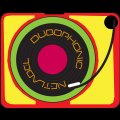
Here I am gluing the bottom end of the
drum… this is a hands on matter! That is
why I prefer this kind of glue. It washes
off! Trust me on this matter… I have worn
glue for days before I learned this.

Once finished evenly gluing all joints
put the clamp back on and adjust all of the
staves. Even them out top and bottom. The
better that you do on this part the less
sanding will be required, because the edges
of each stave line up exactly with the next,
creating a smoother curve. Not my car or
house by the way… Those are the neighbors
LOL

After adjusting the staves, attach two
more hose clamps and tighten the drum evenly
all around. Go over it tightening several
times. Check that each joint has glue
squeezing out a little. Use a wet cloth and
clean out the excess glue from the inside of
the drum. Make sure to spread it into any
place where there may be slight gaps.
Tighten it again. Check to be certain of the
evenness again.

I am cleaning out the excess glue, and
then I will leave it to cure overnight.

Once the glue is dried I use a hand plane
to help remove the glue and begin to round
off the corners of the joints. And then I
use a pneumatic random orbital sander with
very coarse grit sand paper…(I found a
much more effective method for this! I
discovered that using four-inch angle
grinder with an aggressive sanding disc is
PERFECT for this task)

Here is how I do it. This is a long
process. This is just the beginning of the
sanding. This stage is all about shaping the
drum. This is where all the roundness comes
in. Not enough time on this step and you
will see it a lot when you have varnished
the shell. Take your time here. Smooth out
any roughness of the wood… Notice that the
end of the staves is not even… I don’t
stress perfection any place except the width
of the staves and the angles. I will cut off
the ends later to get a nice flat surface.

Here is the shell VERY rough sanded to
40-grit sandpaper. And wiped down with a wet
rag to show the progress…. It is starting
to look like something! (We are going all
the way to at least 220 Grit)

Now I put a clamp back on to use as a
marker to draw a line. I will use this line
to cut off the ends of the shell to be at
the finished length. I make this cut with a
jigsaw. It leaves a nice clean semi flat
edge.

I know my workspace is a total disaster
area! Once I have cut both edges flat, and
have a level end, I finish that up by
sanding that area as flat as I can get it,
and as level as possible. (This picture
seems a bit out of proportion do to trying
to get a picture while holding the camera
and the saw at the same time…)
|


































